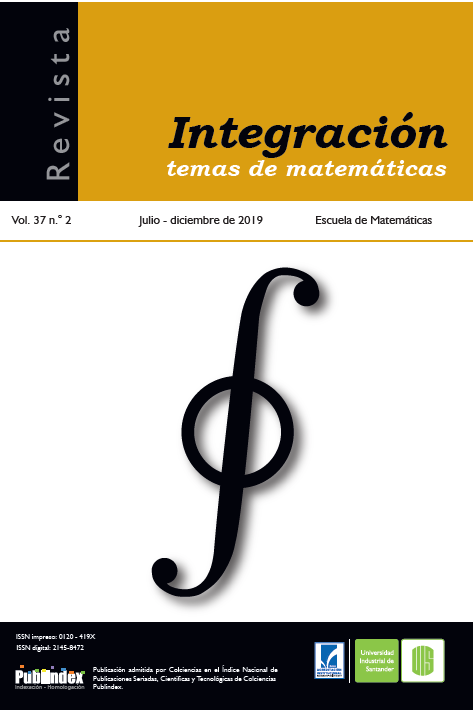Artículos científicos
Publicado 2019-07-29
Palabras clave
- análisis de estabilidad de Von Neumann,
- CFL,
- Local Discontinuous Galerkin (LDG)
Cómo citar
Castillo, P., & Gómez, S. (2019). Análisis de Von Neumann para el método Local Discontinuous Galerkin en 1D. Revista Integración, Temas De matemáticas, 37(2), 199–217. https://doi.org/10.18273/revint.v37n2-2019001
Resumen
Utilizando el análisis de von Neumann como herramienta teórica,
se desarrolla un análisis sobre las condiciones de estabilidad de algunos
métodos explícitos de avance en tiempo, en combinación con la discretización espacial Local Discontinuous Galerkin (LDG) por sus siglas en inglés y aproximaciones de alto orden. La constante de estabilidad CFL (Courant-Friedrichs-Lewy) se estudia en función de los parámetros del método LDG y el grado de aproximación. Se realiza una serie de experimentos numéricos para validar los resultados teóricos.
Descargas
Los datos de descargas todavía no están disponibles.
Referencias
[1] Castillo P., “Stencil reduction algorithms for the Local Discontinuous Galerkin method”, Internat. J. Numer. Methods Engrg. 81 (2010), No. 12, 1475–1491.
[2] Castillo P., Cockburn B., Perugia I. and Schötzau D., “An a priori error analysis of the Local Discontinuous Galerkin method for elliptic problems”, SIAM J. Num. Anal. 38 (2000), No. 5, 1676–1706.
[3] Castillo P., Cockburn B., Schötzau D. and Schwab Ch., “An optimal a priori error estimate for the hp-version of the Local Discontinuous Galerkin method for convection-diffusion problems”, Math. Comp. 71 (2001), No. 238, 455–478.
[4] Castillo P. and Gómez S., “On the conservation of fractional nonlinear Schrödinger equation’s invariants by the Local Discontinuous Galerkin method”, J. Sci. Comput. 77 (2018), No. 3, 1444–1467.
[5] Charney J.G., Fjörtoft R. and Von Neumann J., “Numerical integration of the barotropic vorticity equation”, Tellus 2 (1950), No. 4, 237–254.
[6] Cockburn B. and Dawson C., “Some extensions of the Local Discontinuous Galerkin method for convection diffusion equations in multidimensions”, In Proceedings of the Conference on the Mathematics of Finite Elements and Applications: MAFELAP X( ed. Whiteman J.R.), Elsevier (2000), 225–238.
[7] Cockburn B. and Dong B., “An analysis of the minimal dissipation Local Discontinuous Galerkin method for convection diffusion problems”, SIAM J. Sci. Comput. 32 (2007), No. 2, 233–262.
[8] Cockburn B. and Shu C.W., “The Local Discontinuous Galerkin method for time-dependent convection-diffusion systems”, SIAM J. Num. Anal. 35 (1998), No. 6, 2440–2463.
[9] Gustafsson B., Kreiss H.O. and Oliger J., Time dependent problems and difference methods, John Wiley & Sons, Inc., New York, 1995.
[10] Kubatko E.J., Dawson C. and Westerink J.J., “Time step restrictions for Runge-Kutta discontinuous Galerkin methods on triangular grids”, J. Comput. Phys. 227 (2008), No. 23, 9697–9710.
[11] Kubatko E.J., Westerink J.J. and Dawson C., “Semi discrete discontinuous Galerkin methods and stage-exceeding-order, strong-stability-preserving Runge-Kutta time discretizations”, J. Comput. Phys. 222 (2007), No. 2, 832–848.
[12] Perugia I. and Schötzau D., “An hp-analysis of the Local Discontinuous Galerkin method for diffusion problems”, J. Scientific Computing. 17 (2002), No.1–4, 561–571.
[13] Strikwerda J.C., Finite difference schemes and partial differential equations, SIAM, Philadelphia, 2004.
[14] Toulorge T. and Desmet W., “CFL conditions for Runge-Kutta discontinuous Galerkin methods on triangular grids”, J. Comput. Phys. 230 (2011), No. 12, 4657–4678.
[2] Castillo P., Cockburn B., Perugia I. and Schötzau D., “An a priori error analysis of the Local Discontinuous Galerkin method for elliptic problems”, SIAM J. Num. Anal. 38 (2000), No. 5, 1676–1706.
[3] Castillo P., Cockburn B., Schötzau D. and Schwab Ch., “An optimal a priori error estimate for the hp-version of the Local Discontinuous Galerkin method for convection-diffusion problems”, Math. Comp. 71 (2001), No. 238, 455–478.
[4] Castillo P. and Gómez S., “On the conservation of fractional nonlinear Schrödinger equation’s invariants by the Local Discontinuous Galerkin method”, J. Sci. Comput. 77 (2018), No. 3, 1444–1467.
[5] Charney J.G., Fjörtoft R. and Von Neumann J., “Numerical integration of the barotropic vorticity equation”, Tellus 2 (1950), No. 4, 237–254.
[6] Cockburn B. and Dawson C., “Some extensions of the Local Discontinuous Galerkin method for convection diffusion equations in multidimensions”, In Proceedings of the Conference on the Mathematics of Finite Elements and Applications: MAFELAP X( ed. Whiteman J.R.), Elsevier (2000), 225–238.
[7] Cockburn B. and Dong B., “An analysis of the minimal dissipation Local Discontinuous Galerkin method for convection diffusion problems”, SIAM J. Sci. Comput. 32 (2007), No. 2, 233–262.
[8] Cockburn B. and Shu C.W., “The Local Discontinuous Galerkin method for time-dependent convection-diffusion systems”, SIAM J. Num. Anal. 35 (1998), No. 6, 2440–2463.
[9] Gustafsson B., Kreiss H.O. and Oliger J., Time dependent problems and difference methods, John Wiley & Sons, Inc., New York, 1995.
[10] Kubatko E.J., Dawson C. and Westerink J.J., “Time step restrictions for Runge-Kutta discontinuous Galerkin methods on triangular grids”, J. Comput. Phys. 227 (2008), No. 23, 9697–9710.
[11] Kubatko E.J., Westerink J.J. and Dawson C., “Semi discrete discontinuous Galerkin methods and stage-exceeding-order, strong-stability-preserving Runge-Kutta time discretizations”, J. Comput. Phys. 222 (2007), No. 2, 832–848.
[12] Perugia I. and Schötzau D., “An hp-analysis of the Local Discontinuous Galerkin method for diffusion problems”, J. Scientific Computing. 17 (2002), No.1–4, 561–571.
[13] Strikwerda J.C., Finite difference schemes and partial differential equations, SIAM, Philadelphia, 2004.
[14] Toulorge T. and Desmet W., “CFL conditions for Runge-Kutta discontinuous Galerkin methods on triangular grids”, J. Comput. Phys. 230 (2011), No. 12, 4657–4678.
